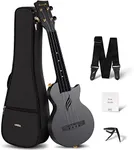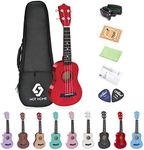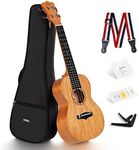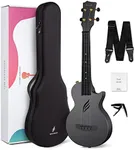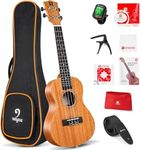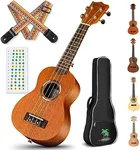Buying Guide for the Best Ukulele For Beginners
Choosing your first ukulele can be exciting, but it’s important to focus on features that will make learning enjoyable and comfortable. As a beginner, you want an instrument that is easy to play, sounds pleasant, and feels good in your hands. Understanding the key specifications will help you find a ukulele that matches your needs and encourages you to keep practicing.SizeUkuleles come in several sizes, with the most common being soprano, concert, tenor, and baritone. Size affects both the sound and the playability. Soprano ukuleles are the smallest and have a bright, classic sound, making them great for younger players or those with smaller hands. Concert ukuleles are slightly larger, offering a bit more space on the fretboard and a fuller sound, which can be more comfortable for adults. Tenor ukuleles are even bigger, providing a deeper tone and more room for finger movement, which some beginners find easier. Baritone ukuleles are the largest and sound more like a guitar, but they are less common for absolute beginners. To pick the right size, consider your hand size, comfort, and the type of sound you prefer.
MaterialUkuleles are made from different materials, mainly wood or laminate. Solid wood ukuleles usually produce a richer, warmer sound, but they can be more delicate and expensive. Laminate ukuleles are made from layers of wood and are more durable and affordable, making them a popular choice for beginners. Some ukuleles also use plastic parts, which can be very sturdy and good for kids. If you’re just starting, a laminate ukulele is often a practical choice, as it balances sound quality and durability.
String TypeMost ukuleles use nylon strings, which are soft on the fingers and easy to press down, making them ideal for beginners. Some ukuleles may have fluorocarbon or other synthetic strings, which can offer a slightly different feel and sound. Metal strings are rare and not recommended for beginners, as they can be harder on the fingers. When choosing, stick with nylon or similar soft strings to make your learning experience more comfortable.
Tuning PegsTuning pegs are the parts you turn to adjust the pitch of the strings. There are two main types: friction pegs and geared pegs. Geared pegs are easier to use and hold tuning better, which is helpful for beginners who are still learning how to tune their instrument. Friction pegs are more traditional but can be trickier to adjust. For a beginner, geared pegs are usually the best choice for hassle-free tuning.
ActionAction refers to how high the strings are above the fretboard. If the action is too high, pressing the strings can be difficult and uncomfortable, especially for beginners. If it’s too low, the strings might buzz. Most beginner ukuleles are set up with medium action, which balances comfort and sound quality. When choosing, look for a ukulele with comfortable action so you can play easily without straining your fingers.
Finish and Build QualityThe finish and build quality affect both the look and durability of the ukulele. A smooth, well-finished instrument will feel better in your hands and last longer. Check for any rough edges, loose parts, or visible glue. A well-built ukulele will be more enjoyable to play and less likely to develop problems as you learn. For beginners, a sturdy, well-finished ukulele is important for a positive learning experience.


